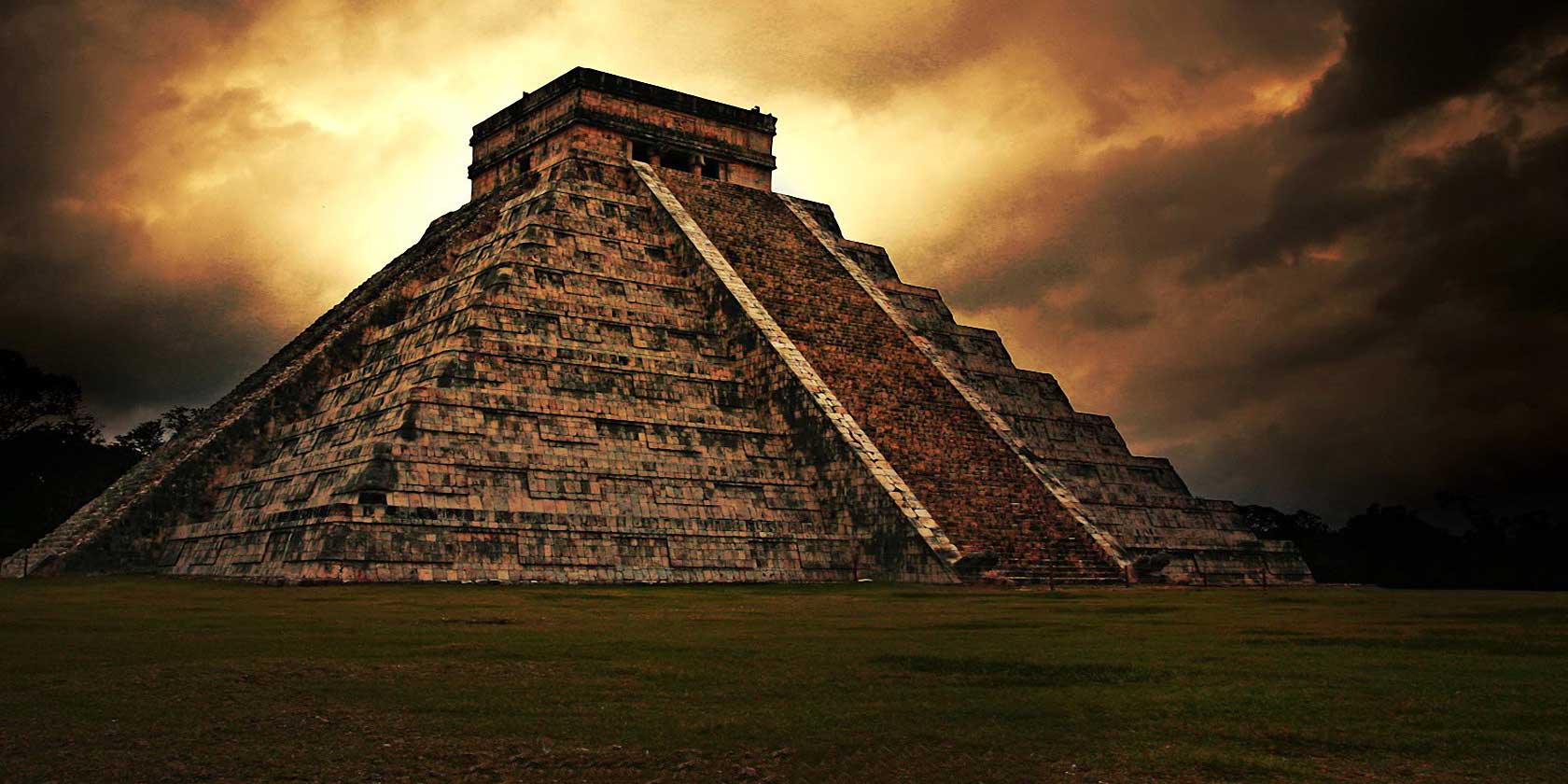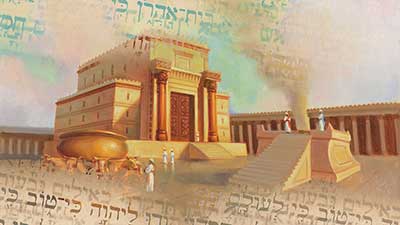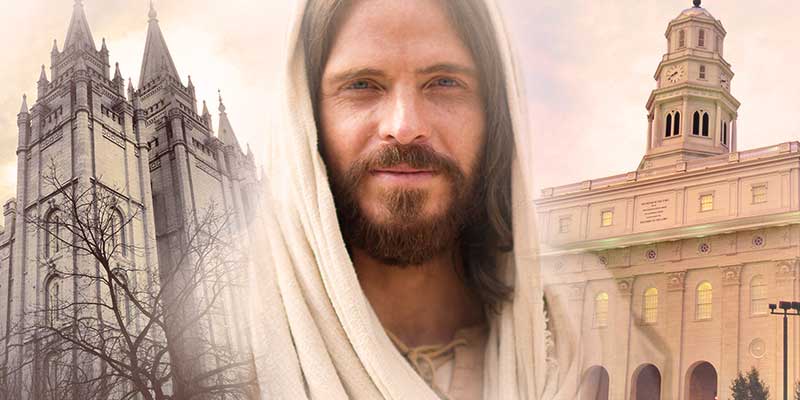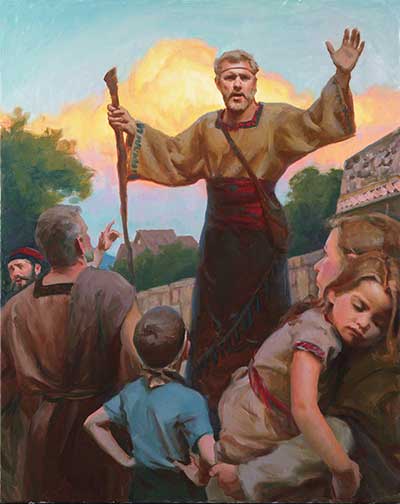
The Know
Alma 5 records one of the greatest addresses of the Book of Mormon, in which Alma the Younger, the Nephite high priest, posed a total of some fifty questions to the members of the Church in Zarahemla.1 These fifty questions are often rhetorical and are meant to help the people of the Church evaluate their spiritual progress and be able to clearly determine which of the “two ways” they are following: the path to eternal life or the path to eternal damnation.2
Alma’s objective with this speech was, apparently, to renew the covenant that was established not only by his father, Alma, at the Waters of Mormon, but also by King Benjamin at the great Nephite gathering that he convened in Zarahemla. For example, some of the repeated words or ideas between Alma’s and Benjamin’s speeches include experiencing a “mighty change” of heart (Alma 5:14; compare Mosiah 5:2) and being spiritually born of God (Alma 5:14; compare Mosiah 5:7).3
When Alma asked the question “can ye look up to God at that day with a pure heart and clean hands” (Alma 5:19), he was quoting Psalm 24:4.4 Psalm 24 is a temple entry psalm that presents worshippers desiring to pass through the gates of the temple as being presented with moral requirements for entry.5 The worshippers ask the guardians of the gates these two questions: “Who shall ascend into the hill of the Lord? Or who shall stand in his holy place?” The answer is then given: “He that hath clean hands, and a pure heart; who hath not lifted up his soul unto vanity, nor sworn deceitfully” (Psalm 24:3–4).
Biblical scholar Sigmund Mowinckel explained that ancient temples had “their own special leges sacrae or 'laws of the sanctuary', their special rules and special demands as to the qualifications of those to be admitted.”6 He notes that Psalm 15, another temple entry psalm parallel to Psalm 24, lists ten requirements for admittance. He believed that at some point these entry requirements became merged with the ten commandments of Mount Sinai, so that entry to the temple involved compliance with these commandments as well.7 Thus, “the instruction as to the conditions of admittance became merged [with] … a renewal of the covenant and a commemoration of the great works of God and of his commandments.”8
Mowinckel believed that these ten commandments of the covenant would have been heard, in the form of questions and answers, at the entry to the gate of the temple and then later at the climax of the pilgrimage festival, at the renewal of the covenant.9 He further described this tradition as a type of “moral catechism.”10 Psalms scholar Craig C. Broyles deduced that the instruction given in this ritual was to help the participant determine which of the “two ways” they would align themselves with—to continue following Jehovah and be identified with “the righteous” or to join the “wicked” forces that oppose him.11
The ancient Israelites were directed to renew the covenant every seven years (sabbatical year) at the Feast of Tabernacles, when they would hear the law read to them and recommit to observe it faithfully (Deuteronomy 31:10–13).
The Why
This information helps explain why Alma asks fifty questions in Alma 5. It is reasonable that Alma’s powerful address to the church in Zarahemla was given in connection with the observation of a sabbatical year, as called for under Israelite tradition. As such, Alma presented his series of introspective questions as part of a covenant renewal ceremony, possibly involving admission into the temple precinct.12 Alma’s speech came in the ninth year of the reign of the judges, 42 years after King Benjamin’s covenant renewal address, or in the sixth sabbatical year since then.13 That would have been the final sabbatical year before the Nephite celebration of the jubilee year, the fiftieth year after King Benjamin’s speech.14 This is conceivably why Alma was keen to quote and echo Benjamin in his speech, and this may also explain why there were exactly fifty questions – as a means of spiritual preparation for the jubilee.
Moreover, Psalm 15, as discussed, presents ten “worthiness” standards, which are stated in both positive (vv. 2, 4) and negative conditions (vv. 3, 5). Psalms scholars Peter C. Craigie and Marvin E. Tate explain the purpose for this: “Both the positive and negative [conditions] are important, for the person who would enter God’s presence must have a life characterized not only by active goodness, but also by the absence of evil.”15 As Craig Broyles stated, the nature of these questions, or standards, is to help the follower define which of the “two ways” he will follow. LDS scholar Mack Stirling has asserted the same for Alma 5.16 In addition, most of Alma’s fifty questions call either for a strongly positive reply or a decisively negative determination.
Alma’s fifty questions were both timely and timeless. They caused the church members in Zarahemla to reflect on the goodness of God in the past, with the desired effect of helping them to have faith in God’s promises and desire to be faithful to their covenants. They also caused the people to reflect on their current spiritual condition and help them to look forward to the day that they would stand before God to be judged of Him. What would that day look like for them? How did the current status of their faithfulness compare to their desired eternal destiny? These powerful and pressing queries could have been readily applied to any subsequent covenant renewal, and they can just as well apply to readers of Alma’s words today.
Further Reading
John W. Welch and J. Gregory Welch, Charting the Book of Mormon: Visual Aids for Personal Study and Teaching (Provo, UT: FARMS, 1999), charts 61–65.
- 1. These questions cluster under eight themes: Questions 1-5, about remembering God’s acts for the benefit of his people; 6-12, on knowing the essential logic of the Gospel; 13-17, probing personal conversion; 18-29, in imagining the day of judgment; 30-36, assessing one’s spiritual condition; 37-38, identifying with a “fold”; 38-40, obtaining spiritual knowledge; and 41-50, counteracting the refusal to repent. See charts 61-65 in John W. and J. Gregory Welch, Charting the Book of Mormon (Provo: FARMS, 1999).
- 2. See Mack C. Stirling, “The Way of Life and the Way of Death in the Book of Mormon,” Journal of Book of Mormon Studies 6, no. 2 (1997): 152–204; Book of Mormon Central, “Are There Really Only Two Churches? (1 Nephi 14:10),” KnoWhy 16 (January 21, 2016).
- 3. For discussion on these parallels, see John W. Welch, “Benjamin, the Man: His Place in Nephite History,” in King Benjamin’s Speech: “That Ye May Learn Wisdom,” ed. John W. Welch and Stephen D. Ricks (Provo, UT: FARMS, 1998), 44; Grant Hardy, Understanding the Book of Mormon: A Reader’s Guide (New York, NY: Oxford University Press, 2010), 133.
- 4. Note that Alma quotes the order of the phrase “clean hands, and a pure heart” backwards. This is likely deliberate, and actually a great indicator that he is indeed quoting from scripture. Scholars have recognized that “when quoting from an earlier source, biblical authors often reversed its sequence.” This phenomenon is known as “Seidel’s Law.” See David E. Bokovoy and John A. Tvedtnes, Testaments: Links between the Book of Mormon and the Hebrew Bible (Tooele, UT: Heritage, 2003), 56–58.
- 5. See, e.g., Craig C. Broyles, "Psalms Concerning the Liturgies of Temple Entry," in The Book of Psalms: Composition and Reception, ed. Peter W. Flint and Patrick D. Miller, Jr. (Leiden; Boston: Brill, 2005), 252; Book of Mormon Central, “Why Does Nephi Quote A Temple Psalm While Commenting on Isaiah? (2 Nephi 25:16),” KnoWhy 51 (March 10, 2016).
- 6. Sigmund Mowinckel, The Psalms in Israel's Worship, trans. D.R. Ap-Thomas, 2 vols. (Oxford: Basil Blackwell, 1962), 1:177.
- 7. Mowinckel further argued that the idea that there were ten commandments (a decalogue) at Sinai is probably derived from this ancient tradition of the temple entry requirements; temple pilgrims were instructed in a way that they could remember--one rule for each finger. Mowinckel, The Psalms, 1:179.
- 8. Mowinckel, The Psalms, 1:178.
- 9. Mowinckel, The Psalms, 1:180.
- 10. Mowinckel, The Psalms, 1:179–180. Such a catechism, or series of moral questions and answers, was common in conversion rituals and covenant renewal ceremonies in ancient Judaism and Christianity. See John W. Welch, The Sermon on the Mount in the Light of the Temple (London: Ashgate, 2009), 193–197; In the Qumran text 1QHa XII, the speaker refers to a group of people that follow him, proclaiming to the Lord that they have “gathered together for your covenant,” and that he has “examined” them (line 25). This is evidently referring to an examination that is taking place at a covenant renewal ceremony.
- 11. Broyles, "Psalms," 286. The other psalms Broyles uses in his argument, and includes as part of the temple entrance liturgy complex, are Psalms 5, 26, 28, 36, and 52. The “righteous” would apparently enter a gate of the inner temple courts called “the gates of righteousness” (see Psalm 118:19–20).
- 12. As his citation of Psalm 24 may suggest.
- 13. At the occasion of King Benjamin’s speech, his son Mosiah was crowned king. Mosiah reigned for 33 years (Mosiah 29:46), and then the reign of the judges began. Alma the Younger left his position as chief judge and went to teach the gospel “full-time” in the ninth year of the reign of the judges (Alma 4:20). This would make 42 years from the time of Benjamin’s address.
- 14. For the idea that King Benjamin’s speech took place during both the sabbatical year and the Jubilee (and also the Feast of Tabernacles), see Terrence L. Szink and John W. Welch, “King Benjamin’s Speech in the Context of Ancient Israelite Festivals,” in Welch and Ricks, King Benjamin’s Speech, 190–199. Book of Mormon Central, “Why Did the Nephites Stay in Their Tents During King Benjamin’s Speech? (Mosiah 2:6),” KnoWhy 80 (April 18, 2016).
- 15. Peter C. Craigie and Marvin E. Tate, Psalms 1–50, vol. 19 of Word Biblical Commentary (second edition; Nashville: Nelson, 2004), 151.
- 16. See Stirling, “The Way of Life and the Way of Death,” 171–173. See also Welch and Welch, Charting the Book of Mormon, chart 71. Alma explicitly identified the two ways: “For I say unto you that whatsoever is good cometh from God, and whatsoever is evil cometh from the devil” (Alma 5:40).
Continue reading at the original source →






